

Sampling at the bow: measuring ocean-atmosphere exchange
One of the main objectives in the NAAMES mission is to understand what gases and particles present in the surface ocean get into the atmosphere and influence clouds and climate. To help answer this question, our group measures gases present in both the ocean and atmosphere, as well as the rate at which the gases are exchanged- that is, how quickly they go into or go out of the ocean.
To do this, we need to observe the natural wind motions and gas concentrations with as small an influence from the ship as possible. The ship disturbs the natural wind field and can also be a source of gases and particles (especially from its exhaust stack). So we go up and out! We install the inlet on the forward mast, which minimizes these impacts from the ship itself. This is where we can get the air most representative of the North Atlantic environment while on board.
So before leaving the dock we lower the forward mast, climb on, and install long sampling inlet tubes. Then, before departing, we raise the mast and run the other end of the tubes back to a mass spectrometer which is running in a container van just aft of the mast. Then (assuming everything is working!) we continuously draw in air and measure two gases (dimethylsulfide and acetone). By simultaneously monitoring the 3D wind direction, we can find out how much of these two gases are entering the atmosphere from the ocean.
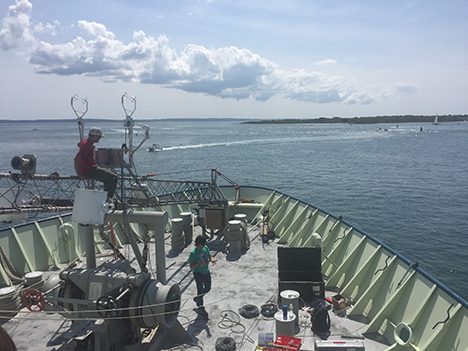
Jack Porter on top of the forward mast installing aerosol sampling inlet. Photo credit: Brian VerWey
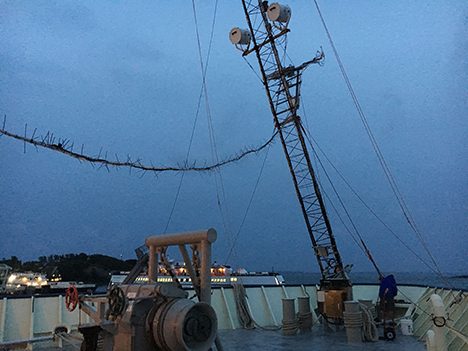
Group leader Tom Bell cranking up the mast before departure
as the Martha’s Vineyard ferry passes. The spiny line leading to the left
is a bundle of thoroughly cable-tied inlet tubes and electrical cables
that go from the mast back to the instrument van.
Written by Mike Lawler
The Royal Treatment
It can be tough saying goodbye to your loved ones as they sail off for a month at sea in the great, wide unknown. And perhaps some of you are concerned about the conditions we might be exposed to – which tropical storms will we collide with, what crazy hours will we be working, and what state of malnourishment will we return in? For the time being, we seem to have dodged the first tropical storm bullet (phew), and while I can’t promise that your loved ones are getting enough sleep at night, I can promise that their stomachs are very well tended to (perhaps a little too well…).
We are certainly getting the royal treatment here aboard the R/V Atlantis, complete with a five-star restaurant catering to our every need. For dinner the other night, we had “lemon, garlic, butter-crumbed scallops” and last night, it was “maple glazed salmon with steamed red potatoes and chives” on offer (and that was only one of the available options)! Now I don’t know about you, but my home-cooked meals don’t come within a cat’s whisker of the caliber of cuisine we receive on the boat. Despite this being my third NAAMES cruise, I am still finding new and exciting foods to try (sometimes in the snack tray, sometimes the meals themselves). The first day at breakfast, I tried a lychee, which screams “do not eat me” from its prickly red outside and isn’t any more inviting on its slimy inside, but it tastes pretty good. The second day, I needed something dry and salty to relieve my churning stomach and resorted to a pack of Fritos (yes, if you hadn’t picked up on it, I’m not from around here) – Fritos are not something I recommend to eat daily, but they get the thumbs up from a sea-sick stomach! Yesterday, I was super excited to try a Chaco taco… I shouldn’t have been! At the risk of insulting fond childhood memories for some, the waffle taco was reminiscent of a damp piece of sweet, chewy cardboard. It’s only redeeming feature was the ice cream. But still, I will continue to relish the new flavors I am lucky enough to experience on board the Atlantis. I wonder what new and exciting foods are in store for us today…
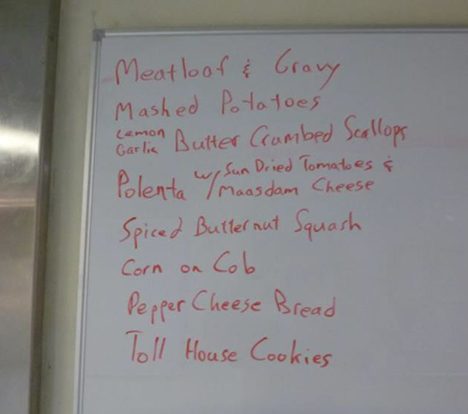
R/V Atlantis Meal Plan
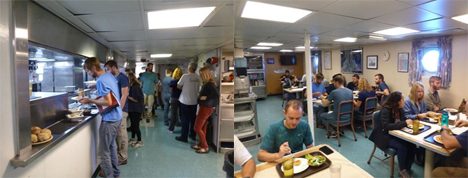
Dinner in the mess hall of the R/V Atlantis
Breakfast is by far my favorite meal! Not only does it top off a stunning sunrise (well, most days), but it begins the flurry of activity in the science labs, and as always, tastes delicious! The array of fruits, yoghurts, and cooked delights enlightens our taste buds and prepares us for the day ahead. And boy are we are going to need it as we finish transiting to our first station this evening. We expect to deploy our first CTD at 1:30 am tomorrow and life will be all hustle and bustle and strange sleep cycles for the next fortnight. But I can assure you that we will be well-fueled and rearing to go!
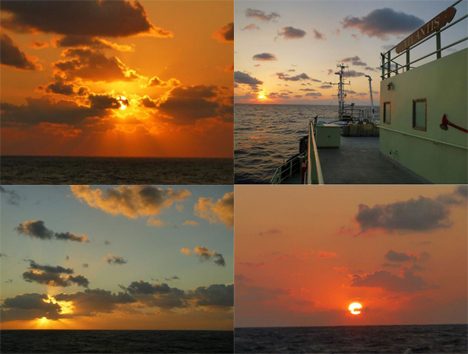
Just a few of the many beautiful sunsets on board the R/V Atlantis
Wish us luck!
Cleo Davie-Martin
P.S. Today, it turns out it was zucchini/banana muffins at breakfast and crab cakes for lunch!
GoPro or How to quantify white caps at the surface of the ocean ?
Several groups of NAAMES are interested in the surface of the ocean covered with white caps.
Why do we care about white caps? White caps have an important role in the air sea exchange, they are a mix of air and sea water that form when a wave break. When bubbles break at the surface they carry out of the water particles (made of viruses, micro-organisms, organic molecules and salts) which when the bubble burst get into the air and become marine aerosols, that influence cloud formation and even hurricane dynamics.
A few models exist mainly based on wind speed and/or wave height but how could we validate them? No one was taking direct measurement on the previous NAAMES campaign. We decided to get cameras to do it, but had only 2 days before leaving dock. We scurried to Best Buy to get GoPros and are now taking pictures of the ocean every 5s, with one camera at each side of the boat. We deployed the cameras in front of the bridge, one of the highest point on board, known for its nice view on the ocean. The only issue with those little cameras is their battery; they last only 2 hours of continuous operation. A little waterproof case was built with the on-board supplies (tape and zip-ties) to protect the wire connection from water. The cameras are continuously running during the day and allow us, with a little bit of image processing, to retrieve the relative amount of white caps at the surface of the ocean.

The GoPro camera setup on starboard of the R/V Atlantis observing white caps during NAAMES III
We collect a little more than 12000 pictures/day and will be happy to share them with anyone having a fun project for them!
Written by Nils Haëntjens and Emmanuel Boss
Fighting bubbles…
On board the R/V Atlantis we have many instruments through which we pump surface water or air to analyze their content while under way or at a station (parked in the middle of the ocean). Unfortunately, something as harmless as a bubble can make a lot of problems for us, as it affects our measurements very strongly (in particular measurements of light scattering as bubble scatter light very efficiently – think of trying to see a fish through breaking waves).
To make the measurements, we pump surface waters into the lab and run them through many instruments, each measuring different properties of ocean particles (which include virus, bacteria and plankton, the tiny micro-organism that are the base of the oceanic food chain).
The pumps we use to obtain ocean water have to be gentle enough not to affect the micro-organisms we are interested in, but strong enough to push the water up 15ft, where our lab is. In order not to sample many bubbles, we pass the water through a de-bubbler, an ingenious device that separates air from water as in a centrifuge (but with no moving parts, only the flowing water is moving through it). However, even with the de-bubbler we kept getting bubbles through our instruments for the first few days of the cruise. We added another one to the system, but still bubbles were making it through. Finally, Catie, the Alvin’s scientific technician and J.T. the Alvin’s chief engineer, went to the front hatch to tune the pump and, surprise, bubbles stopped flooding our instruments. What a relief! Science can begin for real!
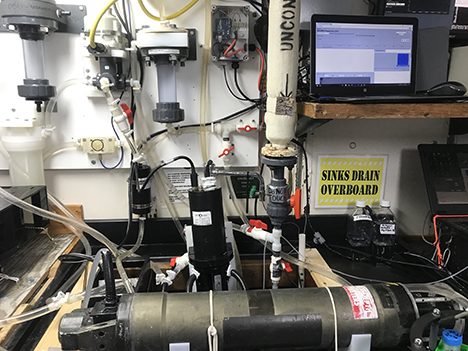
Photo of some of the instruments in the sink of the Bio-Analytical lab, including instrument to measure light scattering and absorption and the size of particles. The two de-bubblers we used are the two similar tubes at the top of the photo, with the left one being the one we do not have to use anymore as the bubble problem has been solved. The computer on the right logs and displays the data.
Written by Emmanuel Boss
If the head count at dinner provides any indication of whether the upper hand belongs to science or the sea, the sea was easily ahead in the first round. After slightly delaying our departure from Woods Hole to allow a tropical storm to pass, we have now been steaming in its wake and feeling its energy as we power through the remaining swell.

Large sea swells from tropical storm as we head off to sea. Photo credit: Cleo Davie-Martin.
With nearly everyone chatting with the great white telephone at some point yesterday, it seems that there were only a lucky few who were truly able to enjoy the excitement accompanying our departure from port.
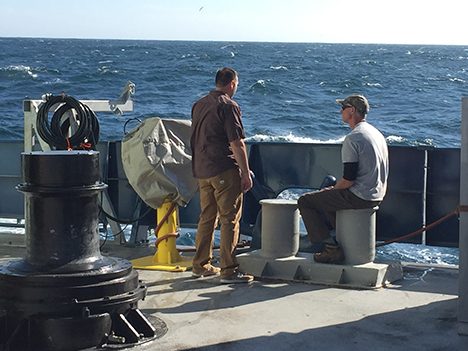
Chief scientist Mike Behrenfeld and Jason Graff enjoying some sunshine on the deck of the R/V Atlantis
Despite the continued swell from the storm ahead of us, we are back on our feet today and nearly everyone made an appearance at both lunch and dinner. And a good thing that people did show up because the cooks have not disappointed! With the cooks accommodating all types of eaters, vegans can remain vegan, vegetarians vegetarian, and I have a feeling that there will be a large contingent of us modifying our belt loops as food becomes as close to sport as we will get out here. Personally, I’m looking forward to Pete hooking into an “Old Man and the Sea” size tuna. Yum. Anytime now Pete.
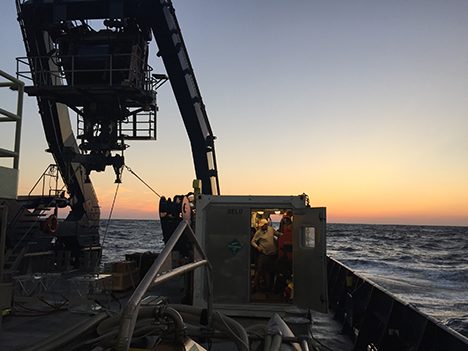
Peter Gaube in his lab van on the back deck of the R/V Atlantis
Speaking of Pete, after he identified a warm core ring just off of our linear course from Woods Hole to Station 1, we modified our route to visit this ring and spent the better part of today steaming through this interesting parcel of Gulf Stream water. At last count the dynamic physical oceanography duo consisting of Pete and Allie had done over 100 casts of their unique CTD through this warm core ring. Science dude. It’s happening.
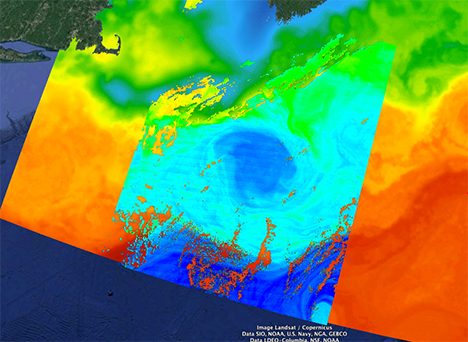
Satellite chl and sea surface temperature composite of warm core ring sampled during NAAMES III.
The seas have substantially calmed down tonight and the gentle late night rolling of the Atlantis has me under its soothing spell. I’ve never been on a dragon before, but the constant motion of the ship conjures half-conscious images and feelings of flying on the back on a large dragon. There’s a good chance I’ve been thinking about that last episode of Game of Thrones a little too much, but heck, if I dream about flying on the back of a dragon tonight I’ll be pretty stoked.
All the best,
Brian VerWey